Finance for Managers Project: Financial Records and Stakeholders
VerifiedAdded on 2020/07/23
|19
|6538
|38
Project
AI Summary
This finance project delves into the core aspects of financial management, covering the purpose and requirements of financial records, analyzing various financial techniques, and assessing their usefulness to stakeholders. It differentiates between management and financial accounting, explores budgetary control processes, and examines different costing methods used for product pricing. The project includes the calculation of variances from provided data and applies investment appraisal techniques, such as the Average Rate of Return (ARR) and the Payback period, to evaluate the viability of a project. The project provides a comprehensive overview of financial management, including balance sheets, income statements, cash flow statements, and statements of changes in equity. The report also analyzes the impact of financial records on stakeholders and how they are used to assess management performance. This project aims to give students a solid understanding of financial analysis, from basic principles to practical application, which is a key component of effective business management.
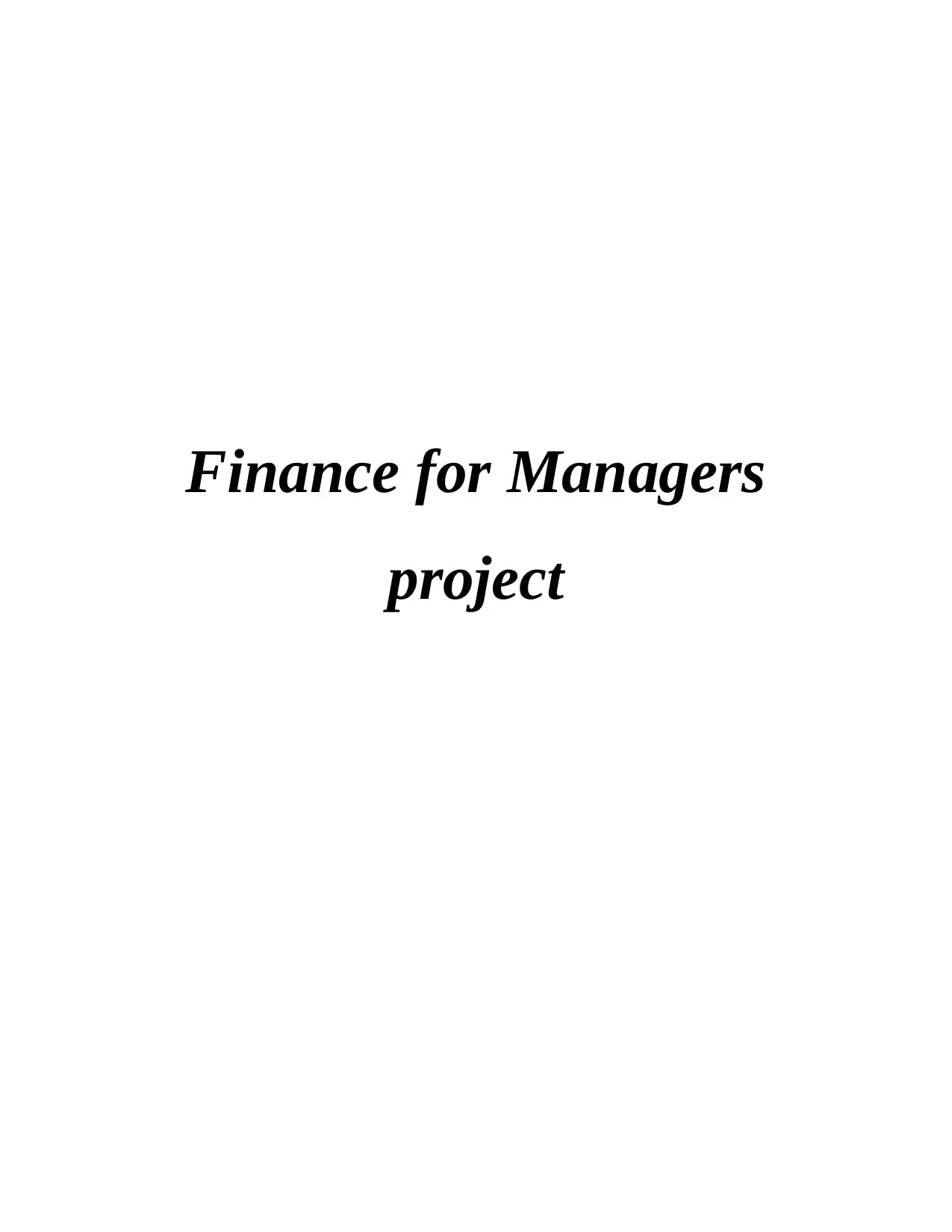
Finance for Managers
project
project
Paraphrase This Document
Need a fresh take? Get an instant paraphrase of this document with our AI Paraphraser
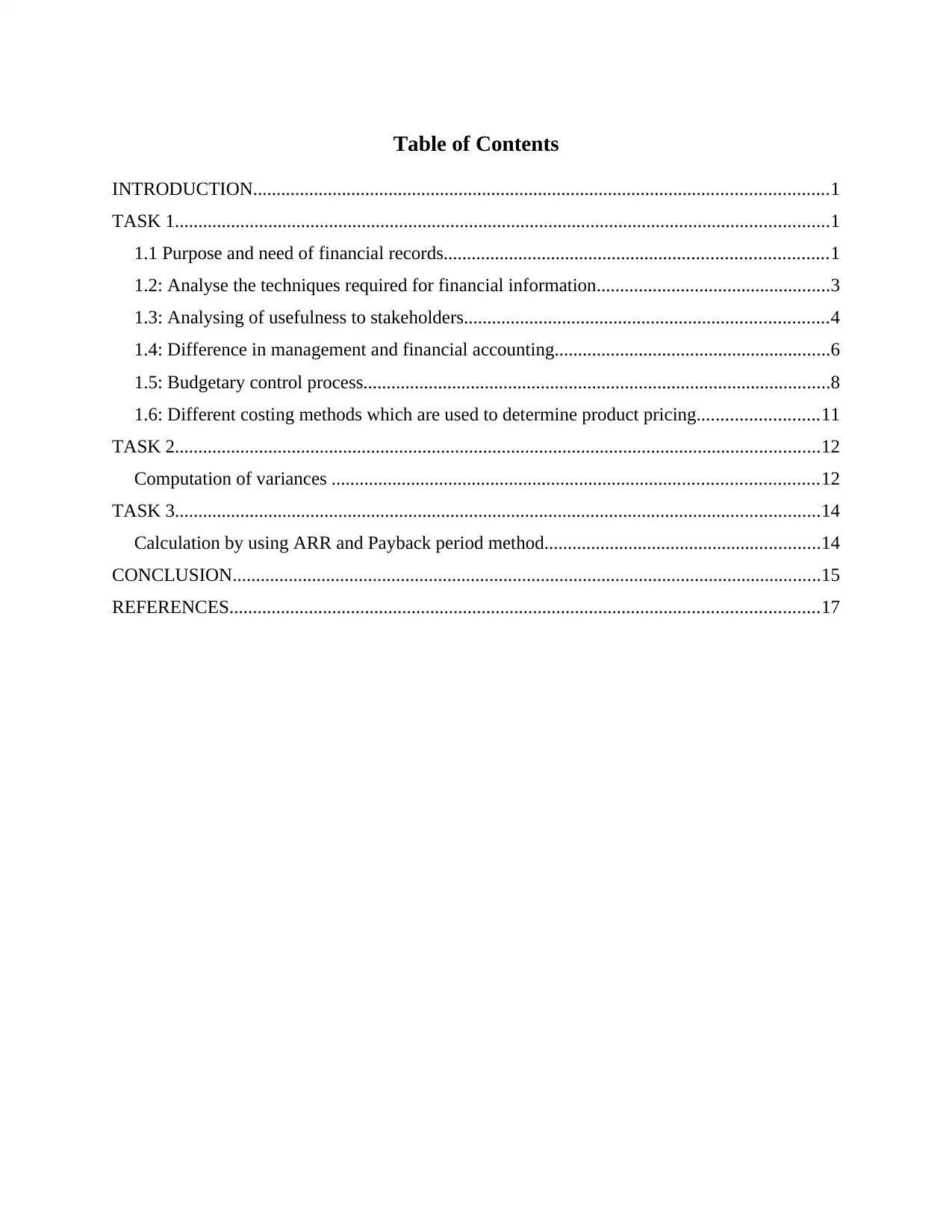
Table of Contents
INTRODUCTION...........................................................................................................................1
TASK 1............................................................................................................................................1
1.1 Purpose and need of financial records..................................................................................1
1.2: Analyse the techniques required for financial information..................................................3
1.3: Analysing of usefulness to stakeholders..............................................................................4
1.4: Difference in management and financial accounting...........................................................6
1.5: Budgetary control process....................................................................................................8
1.6: Different costing methods which are used to determine product pricing..........................11
TASK 2..........................................................................................................................................12
Computation of variances ........................................................................................................12
TASK 3..........................................................................................................................................14
Calculation by using ARR and Payback period method...........................................................14
CONCLUSION..............................................................................................................................15
REFERENCES..............................................................................................................................17
INTRODUCTION...........................................................................................................................1
TASK 1............................................................................................................................................1
1.1 Purpose and need of financial records..................................................................................1
1.2: Analyse the techniques required for financial information..................................................3
1.3: Analysing of usefulness to stakeholders..............................................................................4
1.4: Difference in management and financial accounting...........................................................6
1.5: Budgetary control process....................................................................................................8
1.6: Different costing methods which are used to determine product pricing..........................11
TASK 2..........................................................................................................................................12
Computation of variances ........................................................................................................12
TASK 3..........................................................................................................................................14
Calculation by using ARR and Payback period method...........................................................14
CONCLUSION..............................................................................................................................15
REFERENCES..............................................................................................................................17
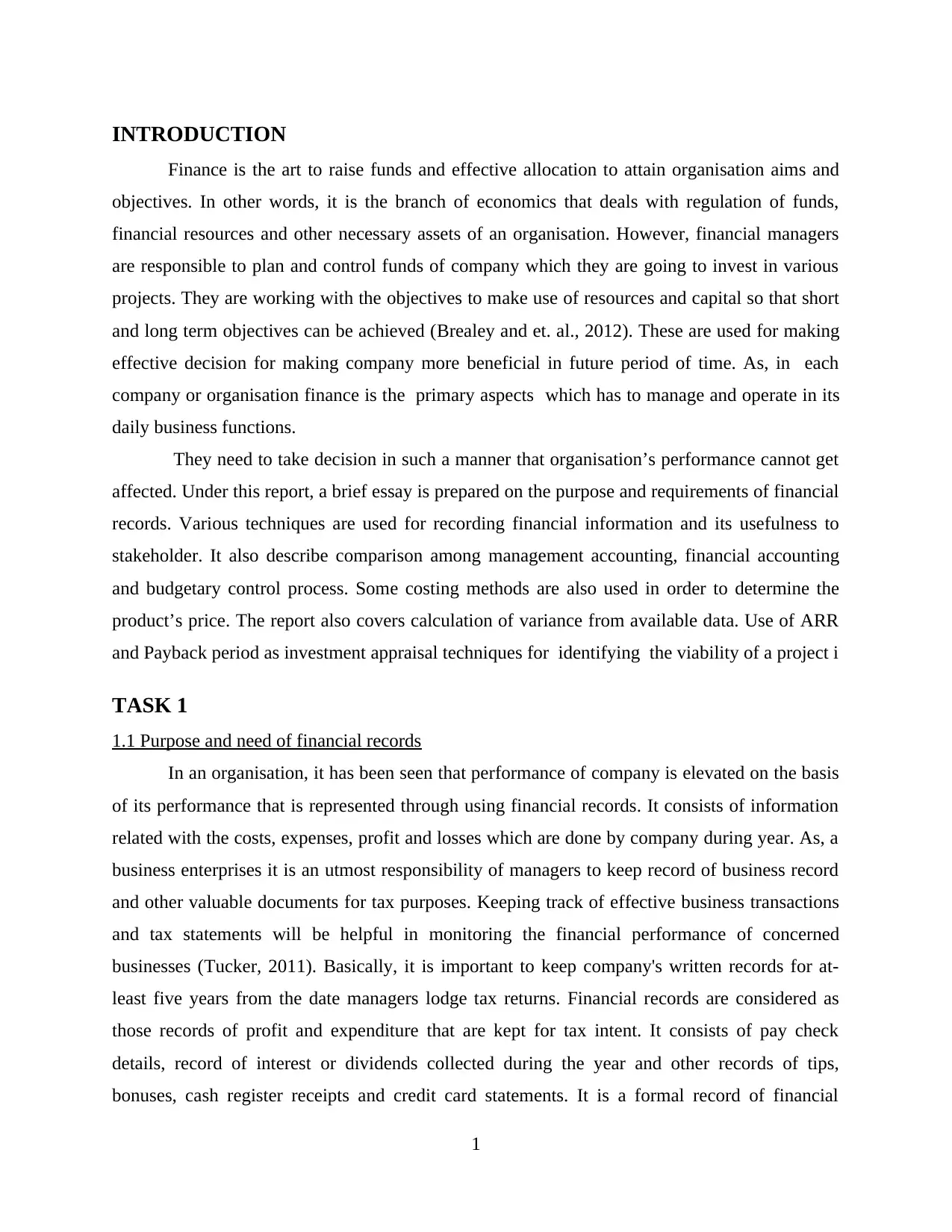
INTRODUCTION
Finance is the art to raise funds and effective allocation to attain organisation aims and
objectives. In other words, it is the branch of economics that deals with regulation of funds,
financial resources and other necessary assets of an organisation. However, financial managers
are responsible to plan and control funds of company which they are going to invest in various
projects. They are working with the objectives to make use of resources and capital so that short
and long term objectives can be achieved (Brealey and et. al., 2012). These are used for making
effective decision for making company more beneficial in future period of time. As, in each
company or organisation finance is the primary aspects which has to manage and operate in its
daily business functions.
They need to take decision in such a manner that organisation’s performance cannot get
affected. Under this report, a brief essay is prepared on the purpose and requirements of financial
records. Various techniques are used for recording financial information and its usefulness to
stakeholder. It also describe comparison among management accounting, financial accounting
and budgetary control process. Some costing methods are also used in order to determine the
product’s price. The report also covers calculation of variance from available data. Use of ARR
and Payback period as investment appraisal techniques for identifying the viability of a project i
TASK 1
1.1 Purpose and need of financial records
In an organisation, it has been seen that performance of company is elevated on the basis
of its performance that is represented through using financial records. It consists of information
related with the costs, expenses, profit and losses which are done by company during year. As, a
business enterprises it is an utmost responsibility of managers to keep record of business record
and other valuable documents for tax purposes. Keeping track of effective business transactions
and tax statements will be helpful in monitoring the financial performance of concerned
businesses (Tucker, 2011). Basically, it is important to keep company's written records for at-
least five years from the date managers lodge tax returns. Financial records are considered as
those records of profit and expenditure that are kept for tax intent. It consists of pay check
details, record of interest or dividends collected during the year and other records of tips,
bonuses, cash register receipts and credit card statements. It is a formal record of financial
1
Finance is the art to raise funds and effective allocation to attain organisation aims and
objectives. In other words, it is the branch of economics that deals with regulation of funds,
financial resources and other necessary assets of an organisation. However, financial managers
are responsible to plan and control funds of company which they are going to invest in various
projects. They are working with the objectives to make use of resources and capital so that short
and long term objectives can be achieved (Brealey and et. al., 2012). These are used for making
effective decision for making company more beneficial in future period of time. As, in each
company or organisation finance is the primary aspects which has to manage and operate in its
daily business functions.
They need to take decision in such a manner that organisation’s performance cannot get
affected. Under this report, a brief essay is prepared on the purpose and requirements of financial
records. Various techniques are used for recording financial information and its usefulness to
stakeholder. It also describe comparison among management accounting, financial accounting
and budgetary control process. Some costing methods are also used in order to determine the
product’s price. The report also covers calculation of variance from available data. Use of ARR
and Payback period as investment appraisal techniques for identifying the viability of a project i
TASK 1
1.1 Purpose and need of financial records
In an organisation, it has been seen that performance of company is elevated on the basis
of its performance that is represented through using financial records. It consists of information
related with the costs, expenses, profit and losses which are done by company during year. As, a
business enterprises it is an utmost responsibility of managers to keep record of business record
and other valuable documents for tax purposes. Keeping track of effective business transactions
and tax statements will be helpful in monitoring the financial performance of concerned
businesses (Tucker, 2011). Basically, it is important to keep company's written records for at-
least five years from the date managers lodge tax returns. Financial records are considered as
those records of profit and expenditure that are kept for tax intent. It consists of pay check
details, record of interest or dividends collected during the year and other records of tips,
bonuses, cash register receipts and credit card statements. It is a formal record of financial
1
⊘ This is a preview!⊘
Do you want full access?
Subscribe today to unlock all pages.

Trusted by 1+ million students worldwide
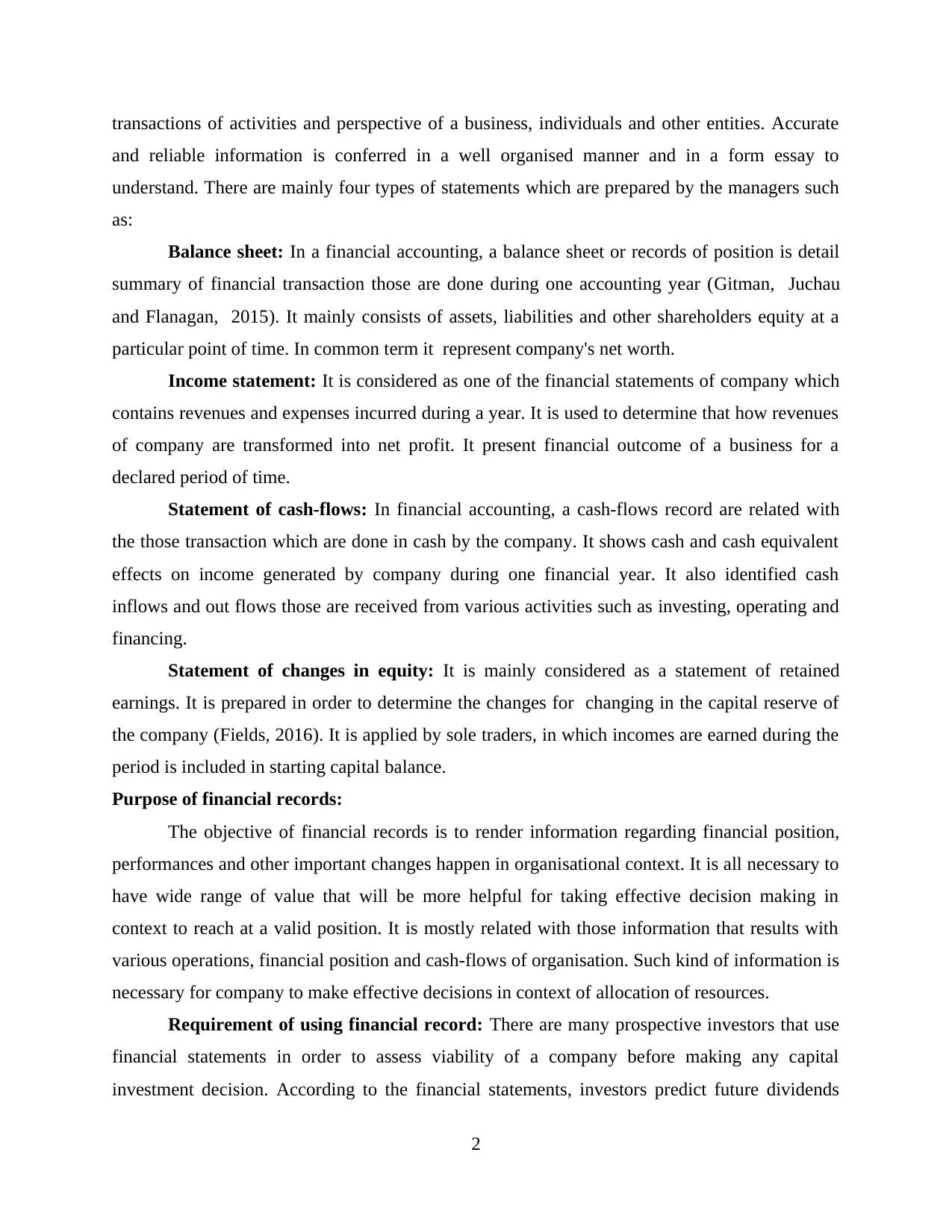
transactions of activities and perspective of a business, individuals and other entities. Accurate
and reliable information is conferred in a well organised manner and in a form essay to
understand. There are mainly four types of statements which are prepared by the managers such
as:
Balance sheet: In a financial accounting, a balance sheet or records of position is detail
summary of financial transaction those are done during one accounting year (Gitman, Juchau
and Flanagan, 2015). It mainly consists of assets, liabilities and other shareholders equity at a
particular point of time. In common term it represent company's net worth.
Income statement: It is considered as one of the financial statements of company which
contains revenues and expenses incurred during a year. It is used to determine that how revenues
of company are transformed into net profit. It present financial outcome of a business for a
declared period of time.
Statement of cash-flows: In financial accounting, a cash-flows record are related with
the those transaction which are done in cash by the company. It shows cash and cash equivalent
effects on income generated by company during one financial year. It also identified cash
inflows and out flows those are received from various activities such as investing, operating and
financing.
Statement of changes in equity: It is mainly considered as a statement of retained
earnings. It is prepared in order to determine the changes for changing in the capital reserve of
the company (Fields, 2016). It is applied by sole traders, in which incomes are earned during the
period is included in starting capital balance.
Purpose of financial records:
The objective of financial records is to render information regarding financial position,
performances and other important changes happen in organisational context. It is all necessary to
have wide range of value that will be more helpful for taking effective decision making in
context to reach at a valid position. It is mostly related with those information that results with
various operations, financial position and cash-flows of organisation. Such kind of information is
necessary for company to make effective decisions in context of allocation of resources.
Requirement of using financial record: There are many prospective investors that use
financial statements in order to assess viability of a company before making any capital
investment decision. According to the financial statements, investors predict future dividends
2
and reliable information is conferred in a well organised manner and in a form essay to
understand. There are mainly four types of statements which are prepared by the managers such
as:
Balance sheet: In a financial accounting, a balance sheet or records of position is detail
summary of financial transaction those are done during one accounting year (Gitman, Juchau
and Flanagan, 2015). It mainly consists of assets, liabilities and other shareholders equity at a
particular point of time. In common term it represent company's net worth.
Income statement: It is considered as one of the financial statements of company which
contains revenues and expenses incurred during a year. It is used to determine that how revenues
of company are transformed into net profit. It present financial outcome of a business for a
declared period of time.
Statement of cash-flows: In financial accounting, a cash-flows record are related with
the those transaction which are done in cash by the company. It shows cash and cash equivalent
effects on income generated by company during one financial year. It also identified cash
inflows and out flows those are received from various activities such as investing, operating and
financing.
Statement of changes in equity: It is mainly considered as a statement of retained
earnings. It is prepared in order to determine the changes for changing in the capital reserve of
the company (Fields, 2016). It is applied by sole traders, in which incomes are earned during the
period is included in starting capital balance.
Purpose of financial records:
The objective of financial records is to render information regarding financial position,
performances and other important changes happen in organisational context. It is all necessary to
have wide range of value that will be more helpful for taking effective decision making in
context to reach at a valid position. It is mostly related with those information that results with
various operations, financial position and cash-flows of organisation. Such kind of information is
necessary for company to make effective decisions in context of allocation of resources.
Requirement of using financial record: There are many prospective investors that use
financial statements in order to assess viability of a company before making any capital
investment decision. According to the financial statements, investors predict future dividends
2
Paraphrase This Document
Need a fresh take? Get an instant paraphrase of this document with our AI Paraphraser
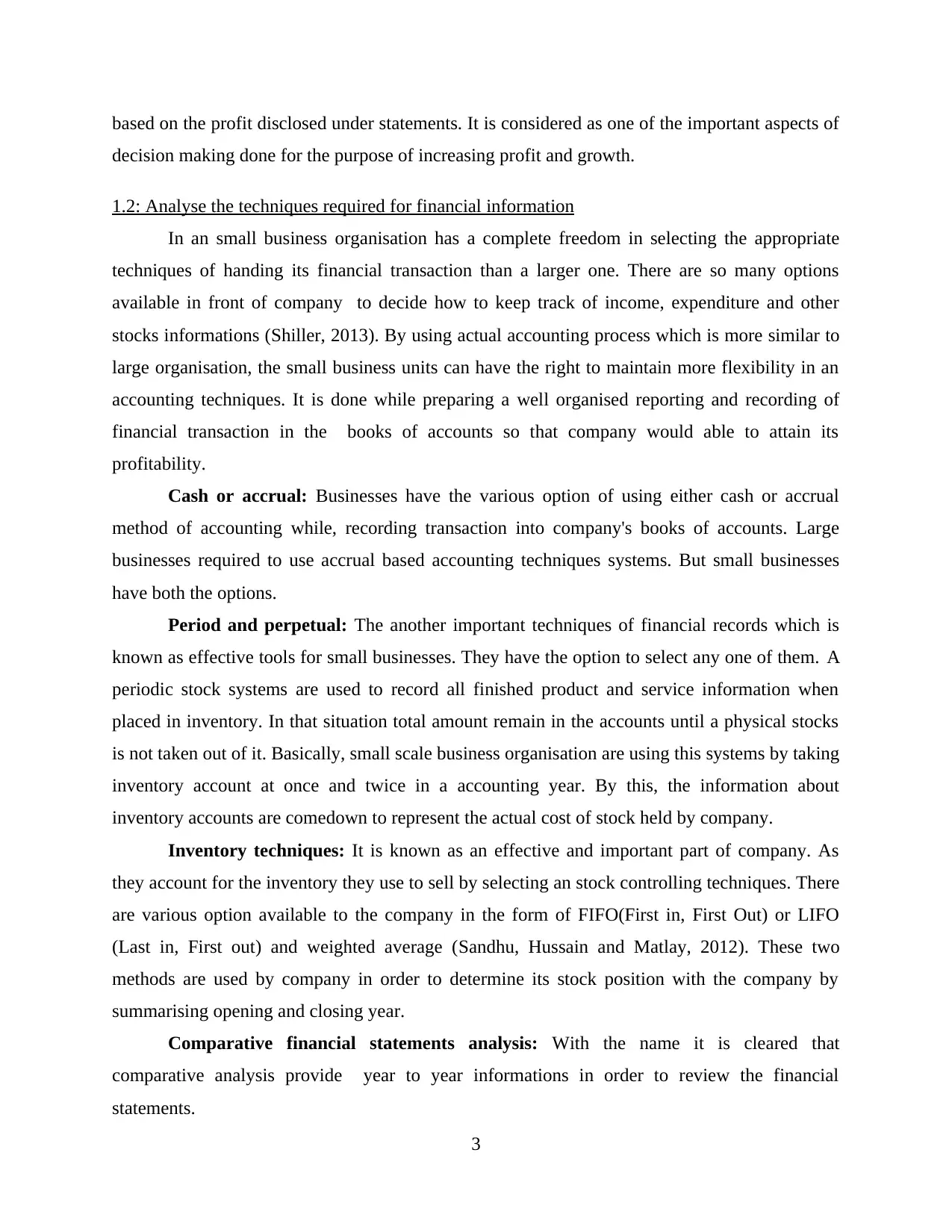
based on the profit disclosed under statements. It is considered as one of the important aspects of
decision making done for the purpose of increasing profit and growth.
1.2: Analyse the techniques required for financial information
In an small business organisation has a complete freedom in selecting the appropriate
techniques of handing its financial transaction than a larger one. There are so many options
available in front of company to decide how to keep track of income, expenditure and other
stocks informations (Shiller, 2013). By using actual accounting process which is more similar to
large organisation, the small business units can have the right to maintain more flexibility in an
accounting techniques. It is done while preparing a well organised reporting and recording of
financial transaction in the books of accounts so that company would able to attain its
profitability.
Cash or accrual: Businesses have the various option of using either cash or accrual
method of accounting while, recording transaction into company's books of accounts. Large
businesses required to use accrual based accounting techniques systems. But small businesses
have both the options.
Period and perpetual: The another important techniques of financial records which is
known as effective tools for small businesses. They have the option to select any one of them. A
periodic stock systems are used to record all finished product and service information when
placed in inventory. In that situation total amount remain in the accounts until a physical stocks
is not taken out of it. Basically, small scale business organisation are using this systems by taking
inventory account at once and twice in a accounting year. By this, the information about
inventory accounts are comedown to represent the actual cost of stock held by company.
Inventory techniques: It is known as an effective and important part of company. As
they account for the inventory they use to sell by selecting an stock controlling techniques. There
are various option available to the company in the form of FIFO(First in, First Out) or LIFO
(Last in, First out) and weighted average (Sandhu, Hussain and Matlay, 2012). These two
methods are used by company in order to determine its stock position with the company by
summarising opening and closing year.
Comparative financial statements analysis: With the name it is cleared that
comparative analysis provide year to year informations in order to review the financial
statements.
3
decision making done for the purpose of increasing profit and growth.
1.2: Analyse the techniques required for financial information
In an small business organisation has a complete freedom in selecting the appropriate
techniques of handing its financial transaction than a larger one. There are so many options
available in front of company to decide how to keep track of income, expenditure and other
stocks informations (Shiller, 2013). By using actual accounting process which is more similar to
large organisation, the small business units can have the right to maintain more flexibility in an
accounting techniques. It is done while preparing a well organised reporting and recording of
financial transaction in the books of accounts so that company would able to attain its
profitability.
Cash or accrual: Businesses have the various option of using either cash or accrual
method of accounting while, recording transaction into company's books of accounts. Large
businesses required to use accrual based accounting techniques systems. But small businesses
have both the options.
Period and perpetual: The another important techniques of financial records which is
known as effective tools for small businesses. They have the option to select any one of them. A
periodic stock systems are used to record all finished product and service information when
placed in inventory. In that situation total amount remain in the accounts until a physical stocks
is not taken out of it. Basically, small scale business organisation are using this systems by taking
inventory account at once and twice in a accounting year. By this, the information about
inventory accounts are comedown to represent the actual cost of stock held by company.
Inventory techniques: It is known as an effective and important part of company. As
they account for the inventory they use to sell by selecting an stock controlling techniques. There
are various option available to the company in the form of FIFO(First in, First Out) or LIFO
(Last in, First out) and weighted average (Sandhu, Hussain and Matlay, 2012). These two
methods are used by company in order to determine its stock position with the company by
summarising opening and closing year.
Comparative financial statements analysis: With the name it is cleared that
comparative analysis provide year to year informations in order to review the financial
statements.
3
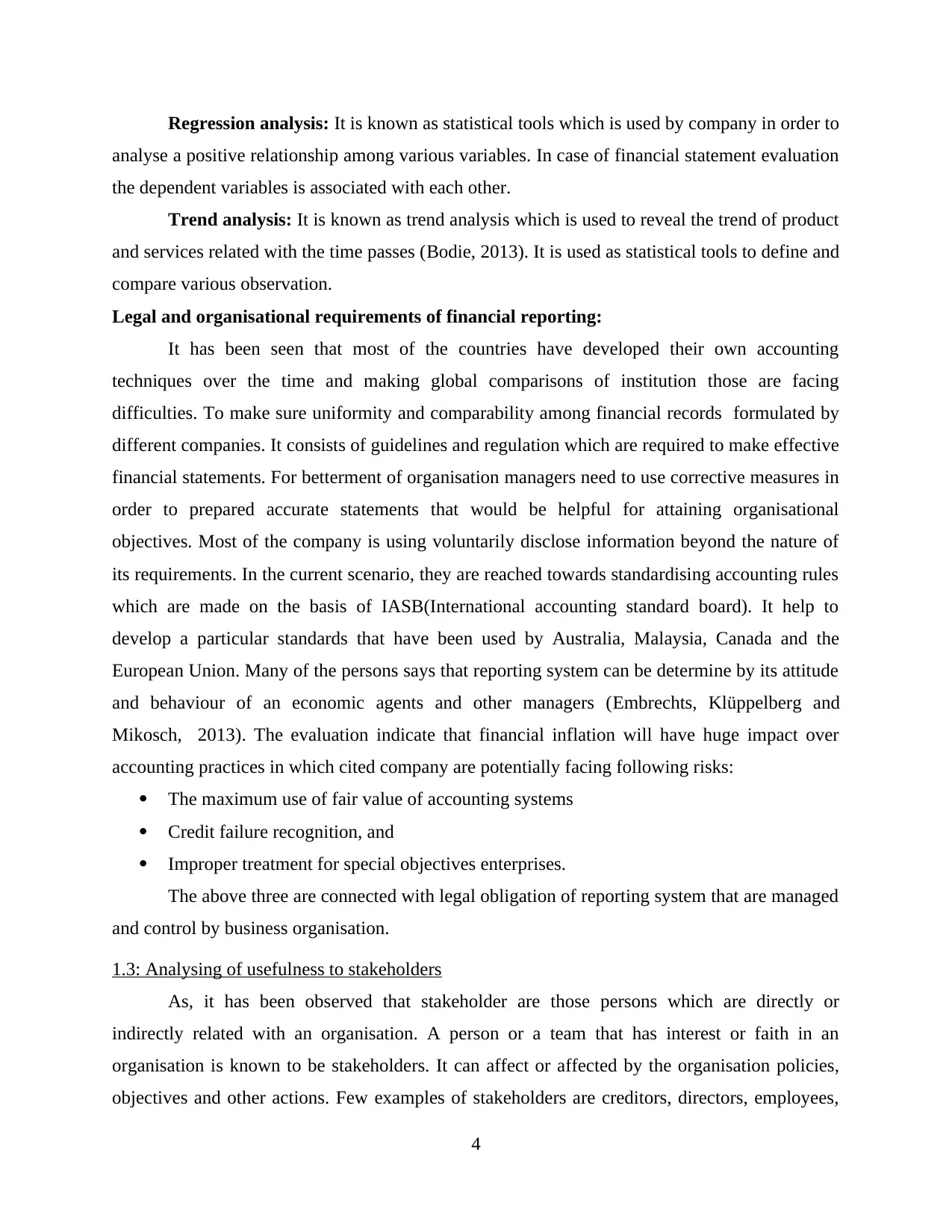
Regression analysis: It is known as statistical tools which is used by company in order to
analyse a positive relationship among various variables. In case of financial statement evaluation
the dependent variables is associated with each other.
Trend analysis: It is known as trend analysis which is used to reveal the trend of product
and services related with the time passes (Bodie, 2013). It is used as statistical tools to define and
compare various observation.
Legal and organisational requirements of financial reporting:
It has been seen that most of the countries have developed their own accounting
techniques over the time and making global comparisons of institution those are facing
difficulties. To make sure uniformity and comparability among financial records formulated by
different companies. It consists of guidelines and regulation which are required to make effective
financial statements. For betterment of organisation managers need to use corrective measures in
order to prepared accurate statements that would be helpful for attaining organisational
objectives. Most of the company is using voluntarily disclose information beyond the nature of
its requirements. In the current scenario, they are reached towards standardising accounting rules
which are made on the basis of IASB(International accounting standard board). It help to
develop a particular standards that have been used by Australia, Malaysia, Canada and the
European Union. Many of the persons says that reporting system can be determine by its attitude
and behaviour of an economic agents and other managers (Embrechts, Klüppelberg and
Mikosch, 2013). The evaluation indicate that financial inflation will have huge impact over
accounting practices in which cited company are potentially facing following risks:
The maximum use of fair value of accounting systems
Credit failure recognition, and
Improper treatment for special objectives enterprises.
The above three are connected with legal obligation of reporting system that are managed
and control by business organisation.
1.3: Analysing of usefulness to stakeholders
As, it has been observed that stakeholder are those persons which are directly or
indirectly related with an organisation. A person or a team that has interest or faith in an
organisation is known to be stakeholders. It can affect or affected by the organisation policies,
objectives and other actions. Few examples of stakeholders are creditors, directors, employees,
4
analyse a positive relationship among various variables. In case of financial statement evaluation
the dependent variables is associated with each other.
Trend analysis: It is known as trend analysis which is used to reveal the trend of product
and services related with the time passes (Bodie, 2013). It is used as statistical tools to define and
compare various observation.
Legal and organisational requirements of financial reporting:
It has been seen that most of the countries have developed their own accounting
techniques over the time and making global comparisons of institution those are facing
difficulties. To make sure uniformity and comparability among financial records formulated by
different companies. It consists of guidelines and regulation which are required to make effective
financial statements. For betterment of organisation managers need to use corrective measures in
order to prepared accurate statements that would be helpful for attaining organisational
objectives. Most of the company is using voluntarily disclose information beyond the nature of
its requirements. In the current scenario, they are reached towards standardising accounting rules
which are made on the basis of IASB(International accounting standard board). It help to
develop a particular standards that have been used by Australia, Malaysia, Canada and the
European Union. Many of the persons says that reporting system can be determine by its attitude
and behaviour of an economic agents and other managers (Embrechts, Klüppelberg and
Mikosch, 2013). The evaluation indicate that financial inflation will have huge impact over
accounting practices in which cited company are potentially facing following risks:
The maximum use of fair value of accounting systems
Credit failure recognition, and
Improper treatment for special objectives enterprises.
The above three are connected with legal obligation of reporting system that are managed
and control by business organisation.
1.3: Analysing of usefulness to stakeholders
As, it has been observed that stakeholder are those persons which are directly or
indirectly related with an organisation. A person or a team that has interest or faith in an
organisation is known to be stakeholders. It can affect or affected by the organisation policies,
objectives and other actions. Few examples of stakeholders are creditors, directors, employees,
4
⊘ This is a preview!⊘
Do you want full access?
Subscribe today to unlock all pages.

Trusted by 1+ million students worldwide
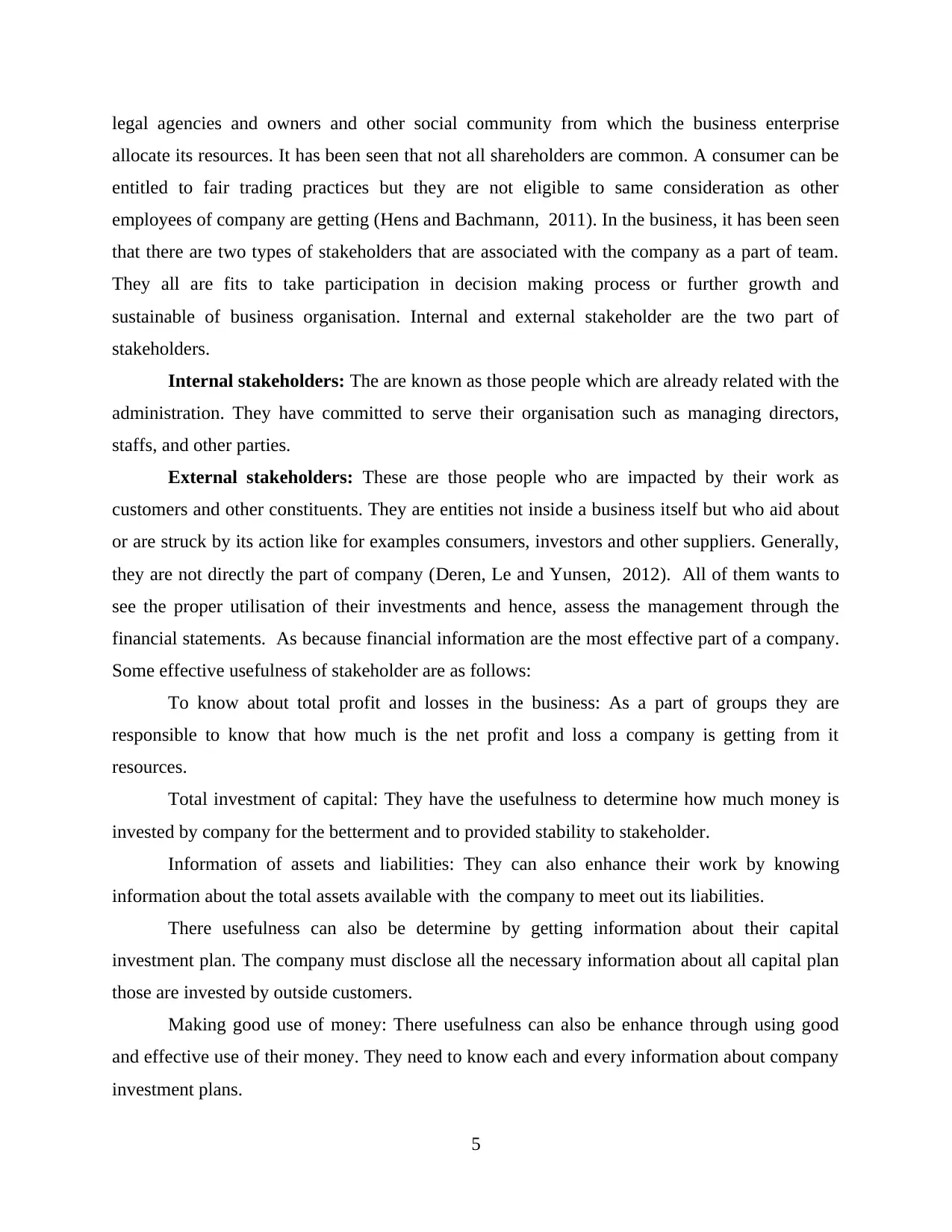
legal agencies and owners and other social community from which the business enterprise
allocate its resources. It has been seen that not all shareholders are common. A consumer can be
entitled to fair trading practices but they are not eligible to same consideration as other
employees of company are getting (Hens and Bachmann, 2011). In the business, it has been seen
that there are two types of stakeholders that are associated with the company as a part of team.
They all are fits to take participation in decision making process or further growth and
sustainable of business organisation. Internal and external stakeholder are the two part of
stakeholders.
Internal stakeholders: The are known as those people which are already related with the
administration. They have committed to serve their organisation such as managing directors,
staffs, and other parties.
External stakeholders: These are those people who are impacted by their work as
customers and other constituents. They are entities not inside a business itself but who aid about
or are struck by its action like for examples consumers, investors and other suppliers. Generally,
they are not directly the part of company (Deren, Le and Yunsen, 2012). All of them wants to
see the proper utilisation of their investments and hence, assess the management through the
financial statements. As because financial information are the most effective part of a company.
Some effective usefulness of stakeholder are as follows:
To know about total profit and losses in the business: As a part of groups they are
responsible to know that how much is the net profit and loss a company is getting from it
resources.
Total investment of capital: They have the usefulness to determine how much money is
invested by company for the betterment and to provided stability to stakeholder.
Information of assets and liabilities: They can also enhance their work by knowing
information about the total assets available with the company to meet out its liabilities.
There usefulness can also be determine by getting information about their capital
investment plan. The company must disclose all the necessary information about all capital plan
those are invested by outside customers.
Making good use of money: There usefulness can also be enhance through using good
and effective use of their money. They need to know each and every information about company
investment plans.
5
allocate its resources. It has been seen that not all shareholders are common. A consumer can be
entitled to fair trading practices but they are not eligible to same consideration as other
employees of company are getting (Hens and Bachmann, 2011). In the business, it has been seen
that there are two types of stakeholders that are associated with the company as a part of team.
They all are fits to take participation in decision making process or further growth and
sustainable of business organisation. Internal and external stakeholder are the two part of
stakeholders.
Internal stakeholders: The are known as those people which are already related with the
administration. They have committed to serve their organisation such as managing directors,
staffs, and other parties.
External stakeholders: These are those people who are impacted by their work as
customers and other constituents. They are entities not inside a business itself but who aid about
or are struck by its action like for examples consumers, investors and other suppliers. Generally,
they are not directly the part of company (Deren, Le and Yunsen, 2012). All of them wants to
see the proper utilisation of their investments and hence, assess the management through the
financial statements. As because financial information are the most effective part of a company.
Some effective usefulness of stakeholder are as follows:
To know about total profit and losses in the business: As a part of groups they are
responsible to know that how much is the net profit and loss a company is getting from it
resources.
Total investment of capital: They have the usefulness to determine how much money is
invested by company for the betterment and to provided stability to stakeholder.
Information of assets and liabilities: They can also enhance their work by knowing
information about the total assets available with the company to meet out its liabilities.
There usefulness can also be determine by getting information about their capital
investment plan. The company must disclose all the necessary information about all capital plan
those are invested by outside customers.
Making good use of money: There usefulness can also be enhance through using good
and effective use of their money. They need to know each and every information about company
investment plans.
5
Paraphrase This Document
Need a fresh take? Get an instant paraphrase of this document with our AI Paraphraser
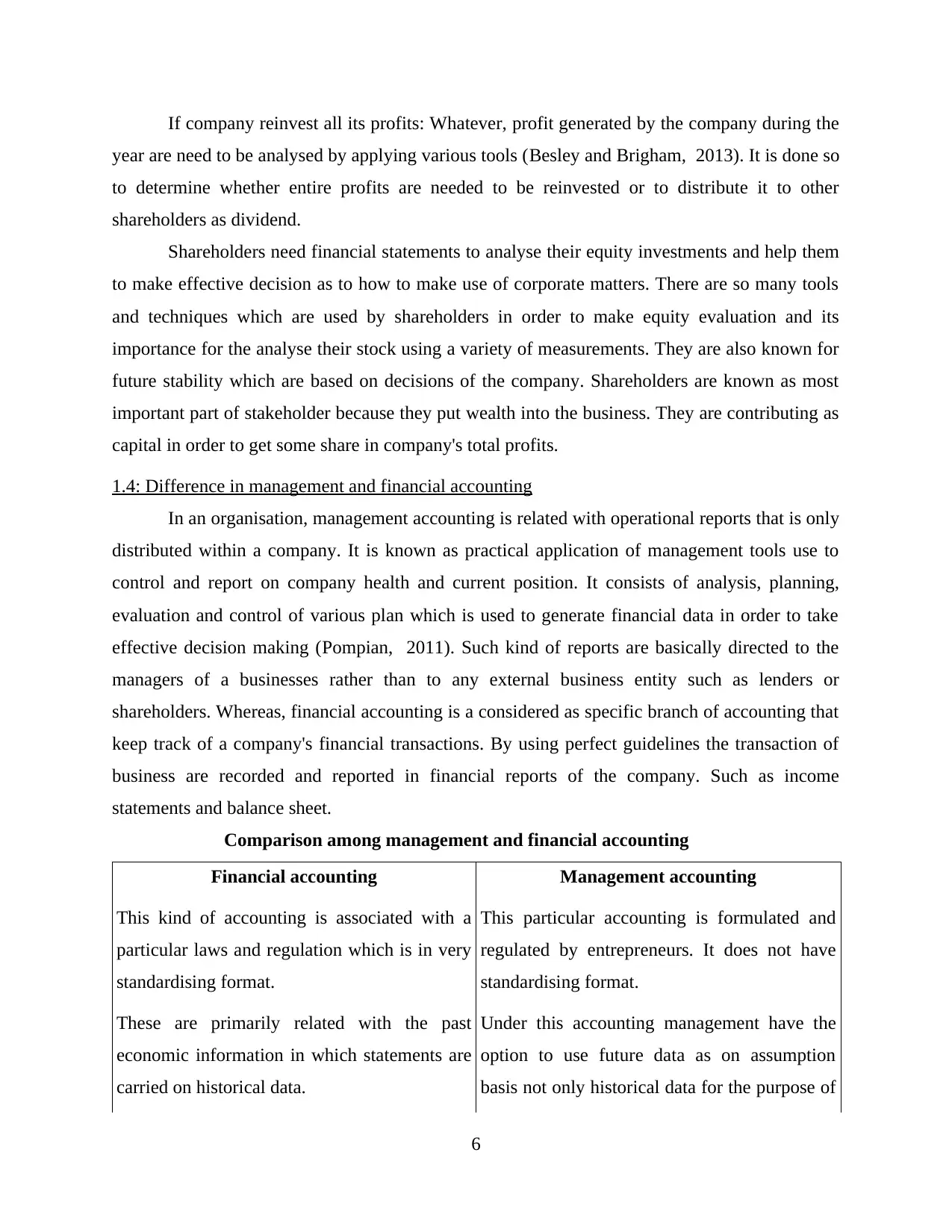
If company reinvest all its profits: Whatever, profit generated by the company during the
year are need to be analysed by applying various tools (Besley and Brigham, 2013). It is done so
to determine whether entire profits are needed to be reinvested or to distribute it to other
shareholders as dividend.
Shareholders need financial statements to analyse their equity investments and help them
to make effective decision as to how to make use of corporate matters. There are so many tools
and techniques which are used by shareholders in order to make equity evaluation and its
importance for the analyse their stock using a variety of measurements. They are also known for
future stability which are based on decisions of the company. Shareholders are known as most
important part of stakeholder because they put wealth into the business. They are contributing as
capital in order to get some share in company's total profits.
1.4: Difference in management and financial accounting
In an organisation, management accounting is related with operational reports that is only
distributed within a company. It is known as practical application of management tools use to
control and report on company health and current position. It consists of analysis, planning,
evaluation and control of various plan which is used to generate financial data in order to take
effective decision making (Pompian, 2011). Such kind of reports are basically directed to the
managers of a businesses rather than to any external business entity such as lenders or
shareholders. Whereas, financial accounting is a considered as specific branch of accounting that
keep track of a company's financial transactions. By using perfect guidelines the transaction of
business are recorded and reported in financial reports of the company. Such as income
statements and balance sheet.
Comparison among management and financial accounting
Financial accounting Management accounting
This kind of accounting is associated with a
particular laws and regulation which is in very
standardising format.
This particular accounting is formulated and
regulated by entrepreneurs. It does not have
standardising format.
These are primarily related with the past
economic information in which statements are
carried on historical data.
Under this accounting management have the
option to use future data as on assumption
basis not only historical data for the purpose of
6
year are need to be analysed by applying various tools (Besley and Brigham, 2013). It is done so
to determine whether entire profits are needed to be reinvested or to distribute it to other
shareholders as dividend.
Shareholders need financial statements to analyse their equity investments and help them
to make effective decision as to how to make use of corporate matters. There are so many tools
and techniques which are used by shareholders in order to make equity evaluation and its
importance for the analyse their stock using a variety of measurements. They are also known for
future stability which are based on decisions of the company. Shareholders are known as most
important part of stakeholder because they put wealth into the business. They are contributing as
capital in order to get some share in company's total profits.
1.4: Difference in management and financial accounting
In an organisation, management accounting is related with operational reports that is only
distributed within a company. It is known as practical application of management tools use to
control and report on company health and current position. It consists of analysis, planning,
evaluation and control of various plan which is used to generate financial data in order to take
effective decision making (Pompian, 2011). Such kind of reports are basically directed to the
managers of a businesses rather than to any external business entity such as lenders or
shareholders. Whereas, financial accounting is a considered as specific branch of accounting that
keep track of a company's financial transactions. By using perfect guidelines the transaction of
business are recorded and reported in financial reports of the company. Such as income
statements and balance sheet.
Comparison among management and financial accounting
Financial accounting Management accounting
This kind of accounting is associated with a
particular laws and regulation which is in very
standardising format.
This particular accounting is formulated and
regulated by entrepreneurs. It does not have
standardising format.
These are primarily related with the past
economic information in which statements are
carried on historical data.
Under this accounting management have the
option to use future data as on assumption
basis not only historical data for the purpose of
6
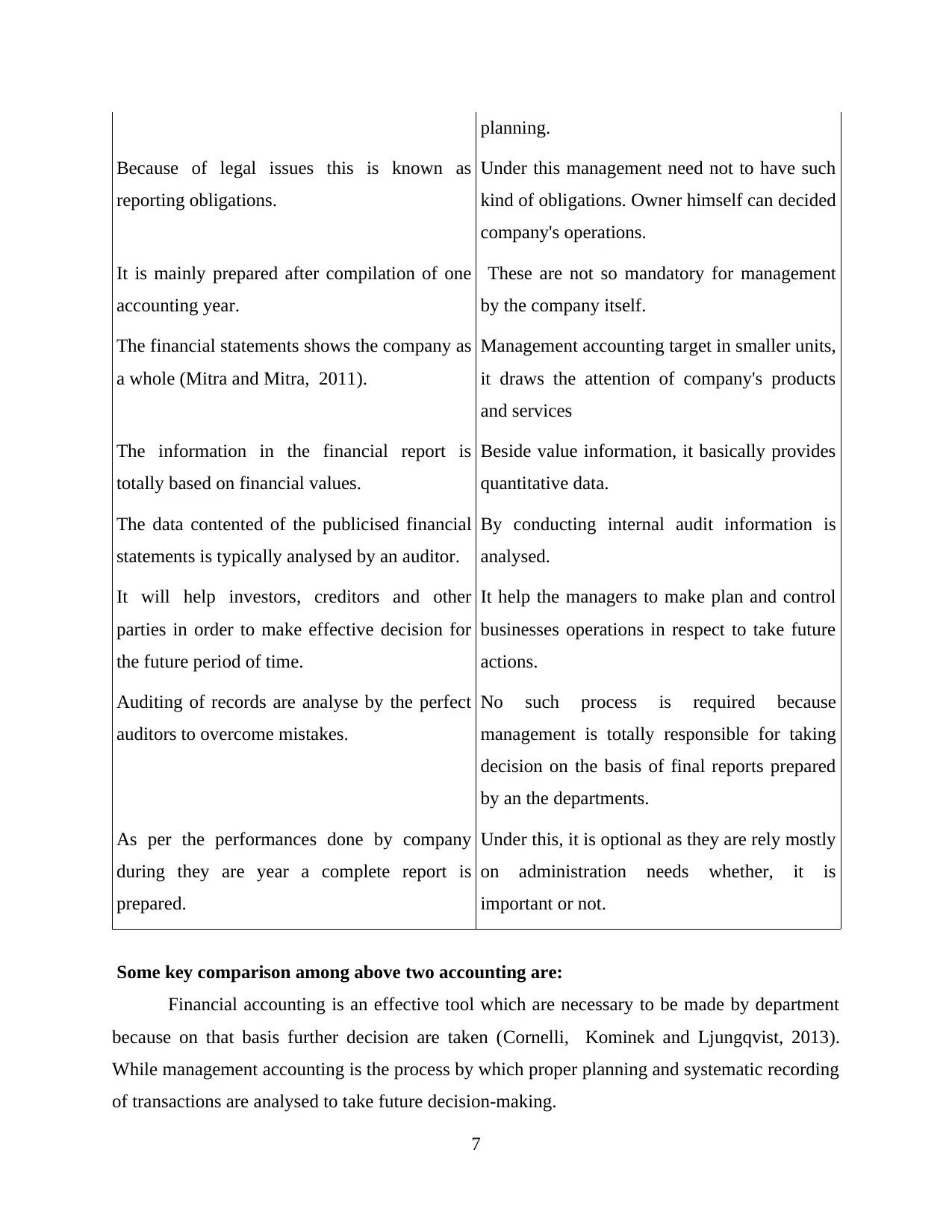
planning.
Because of legal issues this is known as
reporting obligations.
Under this management need not to have such
kind of obligations. Owner himself can decided
company's operations.
It is mainly prepared after compilation of one
accounting year.
These are not so mandatory for management
by the company itself.
The financial statements shows the company as
a whole (Mitra and Mitra, 2011).
Management accounting target in smaller units,
it draws the attention of company's products
and services
The information in the financial report is
totally based on financial values.
Beside value information, it basically provides
quantitative data.
The data contented of the publicised financial
statements is typically analysed by an auditor.
By conducting internal audit information is
analysed.
It will help investors, creditors and other
parties in order to make effective decision for
the future period of time.
It help the managers to make plan and control
businesses operations in respect to take future
actions.
Auditing of records are analyse by the perfect
auditors to overcome mistakes.
No such process is required because
management is totally responsible for taking
decision on the basis of final reports prepared
by an the departments.
As per the performances done by company
during they are year a complete report is
prepared.
Under this, it is optional as they are rely mostly
on administration needs whether, it is
important or not.
Some key comparison among above two accounting are:
Financial accounting is an effective tool which are necessary to be made by department
because on that basis further decision are taken (Cornelli, Kominek and Ljungqvist, 2013).
While management accounting is the process by which proper planning and systematic recording
of transactions are analysed to take future decision-making.
7
Because of legal issues this is known as
reporting obligations.
Under this management need not to have such
kind of obligations. Owner himself can decided
company's operations.
It is mainly prepared after compilation of one
accounting year.
These are not so mandatory for management
by the company itself.
The financial statements shows the company as
a whole (Mitra and Mitra, 2011).
Management accounting target in smaller units,
it draws the attention of company's products
and services
The information in the financial report is
totally based on financial values.
Beside value information, it basically provides
quantitative data.
The data contented of the publicised financial
statements is typically analysed by an auditor.
By conducting internal audit information is
analysed.
It will help investors, creditors and other
parties in order to make effective decision for
the future period of time.
It help the managers to make plan and control
businesses operations in respect to take future
actions.
Auditing of records are analyse by the perfect
auditors to overcome mistakes.
No such process is required because
management is totally responsible for taking
decision on the basis of final reports prepared
by an the departments.
As per the performances done by company
during they are year a complete report is
prepared.
Under this, it is optional as they are rely mostly
on administration needs whether, it is
important or not.
Some key comparison among above two accounting are:
Financial accounting is an effective tool which are necessary to be made by department
because on that basis further decision are taken (Cornelli, Kominek and Ljungqvist, 2013).
While management accounting is the process by which proper planning and systematic recording
of transactions are analysed to take future decision-making.
7
⊘ This is a preview!⊘
Do you want full access?
Subscribe today to unlock all pages.

Trusted by 1+ million students worldwide
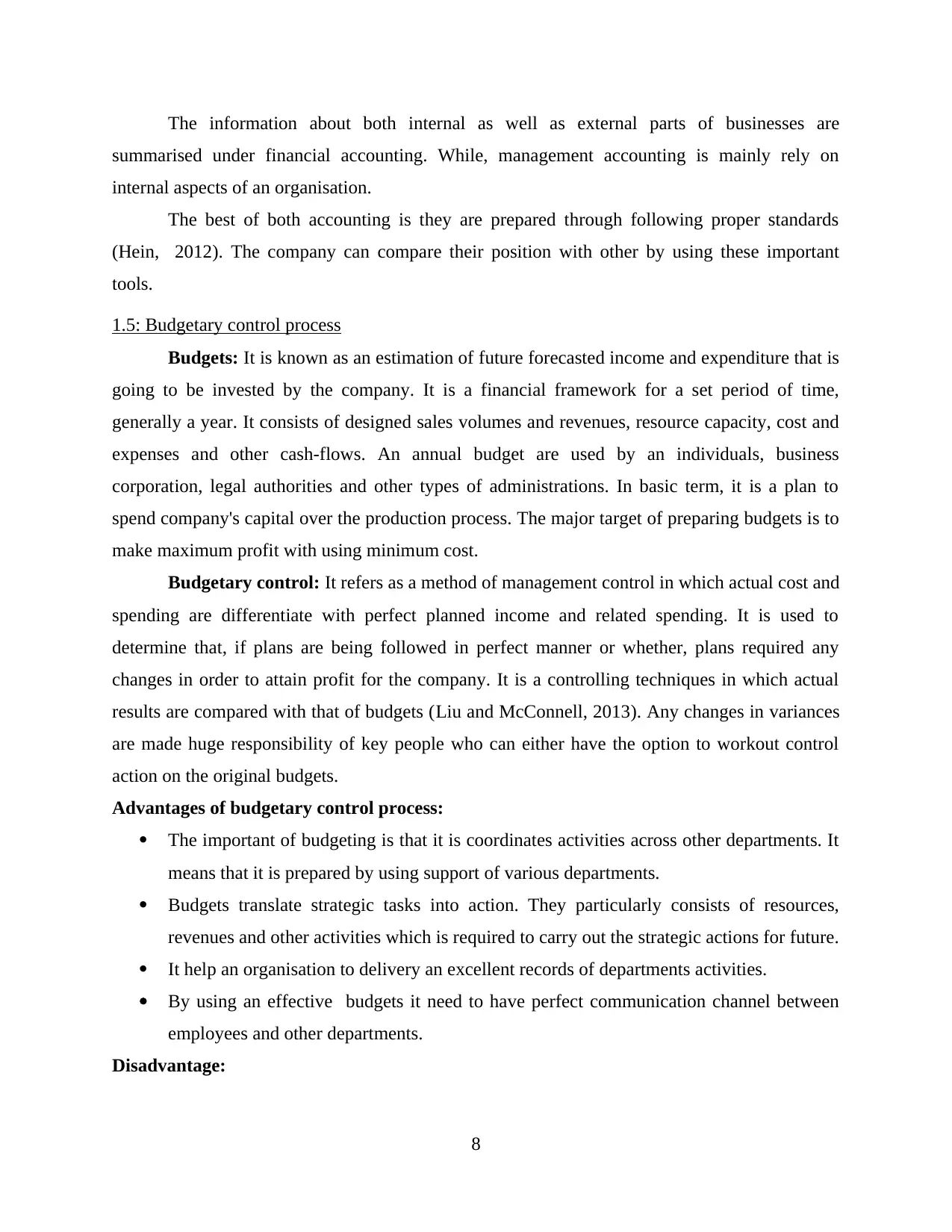
The information about both internal as well as external parts of businesses are
summarised under financial accounting. While, management accounting is mainly rely on
internal aspects of an organisation.
The best of both accounting is they are prepared through following proper standards
(Hein, 2012). The company can compare their position with other by using these important
tools.
1.5: Budgetary control process
Budgets: It is known as an estimation of future forecasted income and expenditure that is
going to be invested by the company. It is a financial framework for a set period of time,
generally a year. It consists of designed sales volumes and revenues, resource capacity, cost and
expenses and other cash-flows. An annual budget are used by an individuals, business
corporation, legal authorities and other types of administrations. In basic term, it is a plan to
spend company's capital over the production process. The major target of preparing budgets is to
make maximum profit with using minimum cost.
Budgetary control: It refers as a method of management control in which actual cost and
spending are differentiate with perfect planned income and related spending. It is used to
determine that, if plans are being followed in perfect manner or whether, plans required any
changes in order to attain profit for the company. It is a controlling techniques in which actual
results are compared with that of budgets (Liu and McConnell, 2013). Any changes in variances
are made huge responsibility of key people who can either have the option to workout control
action on the original budgets.
Advantages of budgetary control process:
The important of budgeting is that it is coordinates activities across other departments. It
means that it is prepared by using support of various departments.
Budgets translate strategic tasks into action. They particularly consists of resources,
revenues and other activities which is required to carry out the strategic actions for future.
It help an organisation to delivery an excellent records of departments activities.
By using an effective budgets it need to have perfect communication channel between
employees and other departments.
Disadvantage:
8
summarised under financial accounting. While, management accounting is mainly rely on
internal aspects of an organisation.
The best of both accounting is they are prepared through following proper standards
(Hein, 2012). The company can compare their position with other by using these important
tools.
1.5: Budgetary control process
Budgets: It is known as an estimation of future forecasted income and expenditure that is
going to be invested by the company. It is a financial framework for a set period of time,
generally a year. It consists of designed sales volumes and revenues, resource capacity, cost and
expenses and other cash-flows. An annual budget are used by an individuals, business
corporation, legal authorities and other types of administrations. In basic term, it is a plan to
spend company's capital over the production process. The major target of preparing budgets is to
make maximum profit with using minimum cost.
Budgetary control: It refers as a method of management control in which actual cost and
spending are differentiate with perfect planned income and related spending. It is used to
determine that, if plans are being followed in perfect manner or whether, plans required any
changes in order to attain profit for the company. It is a controlling techniques in which actual
results are compared with that of budgets (Liu and McConnell, 2013). Any changes in variances
are made huge responsibility of key people who can either have the option to workout control
action on the original budgets.
Advantages of budgetary control process:
The important of budgeting is that it is coordinates activities across other departments. It
means that it is prepared by using support of various departments.
Budgets translate strategic tasks into action. They particularly consists of resources,
revenues and other activities which is required to carry out the strategic actions for future.
It help an organisation to delivery an excellent records of departments activities.
By using an effective budgets it need to have perfect communication channel between
employees and other departments.
Disadvantage:
8
Paraphrase This Document
Need a fresh take? Get an instant paraphrase of this document with our AI Paraphraser
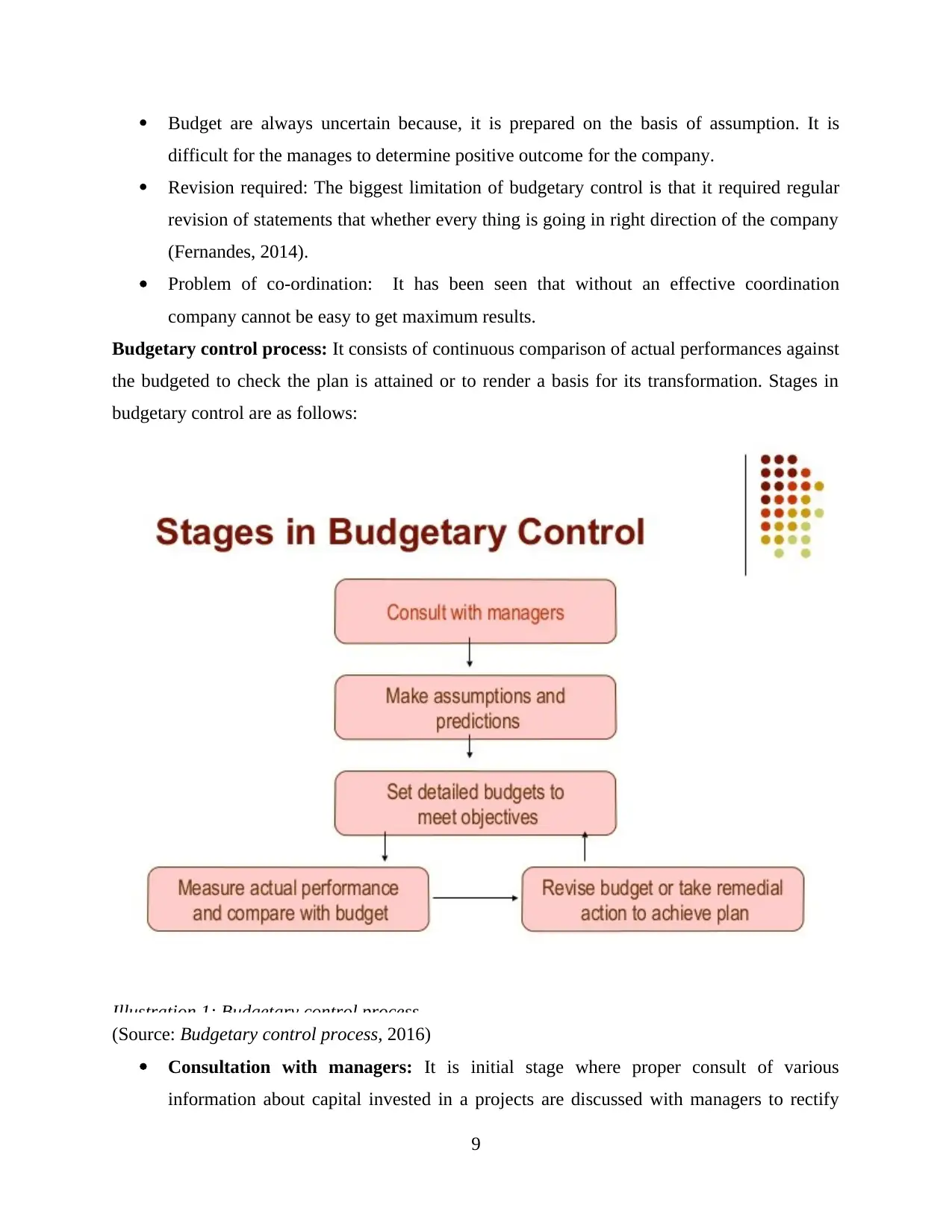
Budget are always uncertain because, it is prepared on the basis of assumption. It is
difficult for the manages to determine positive outcome for the company.
Revision required: The biggest limitation of budgetary control is that it required regular
revision of statements that whether every thing is going in right direction of the company
(Fernandes, 2014).
Problem of co-ordination: It has been seen that without an effective coordination
company cannot be easy to get maximum results.
Budgetary control process: It consists of continuous comparison of actual performances against
the budgeted to check the plan is attained or to render a basis for its transformation. Stages in
budgetary control are as follows:
Illustration 1: Budgetary control process
(Source: Budgetary control process, 2016)
Consultation with managers: It is initial stage where proper consult of various
information about capital invested in a projects are discussed with managers to rectify
9
difficult for the manages to determine positive outcome for the company.
Revision required: The biggest limitation of budgetary control is that it required regular
revision of statements that whether every thing is going in right direction of the company
(Fernandes, 2014).
Problem of co-ordination: It has been seen that without an effective coordination
company cannot be easy to get maximum results.
Budgetary control process: It consists of continuous comparison of actual performances against
the budgeted to check the plan is attained or to render a basis for its transformation. Stages in
budgetary control are as follows:
Illustration 1: Budgetary control process
(Source: Budgetary control process, 2016)
Consultation with managers: It is initial stage where proper consult of various
information about capital invested in a projects are discussed with managers to rectify
9
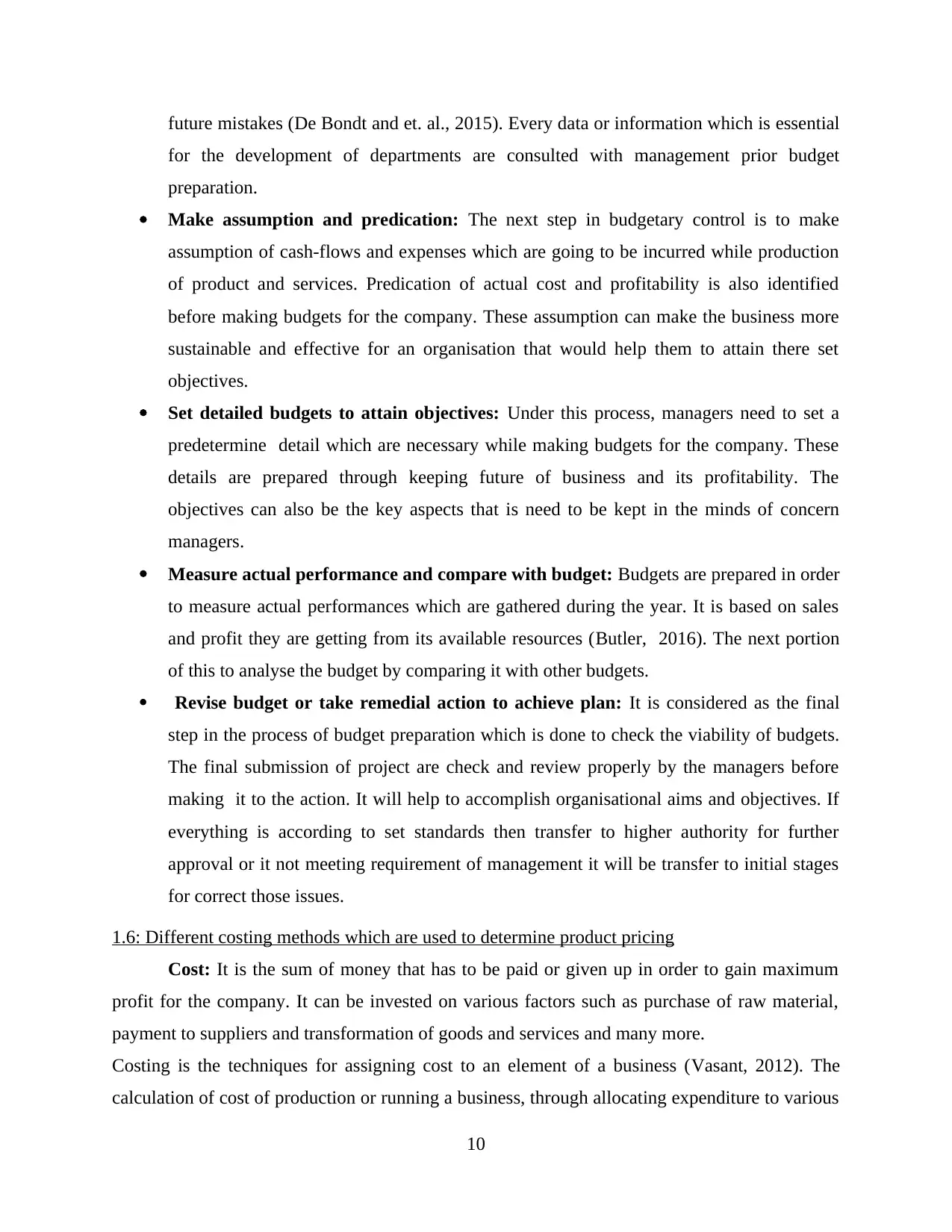
future mistakes (De Bondt and et. al., 2015). Every data or information which is essential
for the development of departments are consulted with management prior budget
preparation.
Make assumption and predication: The next step in budgetary control is to make
assumption of cash-flows and expenses which are going to be incurred while production
of product and services. Predication of actual cost and profitability is also identified
before making budgets for the company. These assumption can make the business more
sustainable and effective for an organisation that would help them to attain there set
objectives.
Set detailed budgets to attain objectives: Under this process, managers need to set a
predetermine detail which are necessary while making budgets for the company. These
details are prepared through keeping future of business and its profitability. The
objectives can also be the key aspects that is need to be kept in the minds of concern
managers.
Measure actual performance and compare with budget: Budgets are prepared in order
to measure actual performances which are gathered during the year. It is based on sales
and profit they are getting from its available resources (Butler, 2016). The next portion
of this to analyse the budget by comparing it with other budgets.
Revise budget or take remedial action to achieve plan: It is considered as the final
step in the process of budget preparation which is done to check the viability of budgets.
The final submission of project are check and review properly by the managers before
making it to the action. It will help to accomplish organisational aims and objectives. If
everything is according to set standards then transfer to higher authority for further
approval or it not meeting requirement of management it will be transfer to initial stages
for correct those issues.
1.6: Different costing methods which are used to determine product pricing
Cost: It is the sum of money that has to be paid or given up in order to gain maximum
profit for the company. It can be invested on various factors such as purchase of raw material,
payment to suppliers and transformation of goods and services and many more.
Costing is the techniques for assigning cost to an element of a business (Vasant, 2012). The
calculation of cost of production or running a business, through allocating expenditure to various
10
for the development of departments are consulted with management prior budget
preparation.
Make assumption and predication: The next step in budgetary control is to make
assumption of cash-flows and expenses which are going to be incurred while production
of product and services. Predication of actual cost and profitability is also identified
before making budgets for the company. These assumption can make the business more
sustainable and effective for an organisation that would help them to attain there set
objectives.
Set detailed budgets to attain objectives: Under this process, managers need to set a
predetermine detail which are necessary while making budgets for the company. These
details are prepared through keeping future of business and its profitability. The
objectives can also be the key aspects that is need to be kept in the minds of concern
managers.
Measure actual performance and compare with budget: Budgets are prepared in order
to measure actual performances which are gathered during the year. It is based on sales
and profit they are getting from its available resources (Butler, 2016). The next portion
of this to analyse the budget by comparing it with other budgets.
Revise budget or take remedial action to achieve plan: It is considered as the final
step in the process of budget preparation which is done to check the viability of budgets.
The final submission of project are check and review properly by the managers before
making it to the action. It will help to accomplish organisational aims and objectives. If
everything is according to set standards then transfer to higher authority for further
approval or it not meeting requirement of management it will be transfer to initial stages
for correct those issues.
1.6: Different costing methods which are used to determine product pricing
Cost: It is the sum of money that has to be paid or given up in order to gain maximum
profit for the company. It can be invested on various factors such as purchase of raw material,
payment to suppliers and transformation of goods and services and many more.
Costing is the techniques for assigning cost to an element of a business (Vasant, 2012). The
calculation of cost of production or running a business, through allocating expenditure to various
10
⊘ This is a preview!⊘
Do you want full access?
Subscribe today to unlock all pages.

Trusted by 1+ million students worldwide
1 out of 19
Related Documents
Your All-in-One AI-Powered Toolkit for Academic Success.
+13062052269
info@desklib.com
Available 24*7 on WhatsApp / Email
![[object Object]](/_next/static/media/star-bottom.7253800d.svg)
Unlock your academic potential
Copyright © 2020–2025 A2Z Services. All Rights Reserved. Developed and managed by ZUCOL.





